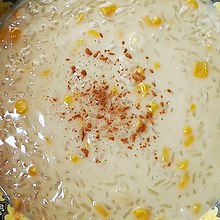Ginataan
Ginataan (pronounced: GHEE-nah-ta-AN), alternatively spelled guinataan, is a Filipino term which refers to food cooked with gatâ (coconut milk). Literally translated, ginataan means "done with coconut milk". Due to the general nature of the term, it may refer to a number of different dishes, each called ginataan, but distinct from one another.
  Top: Ginataang kalabasa (calabaza and string beans in coconut milk) with shrimp; Bottom: Ginataang mais, a dessert rice gruel (lugaw) with sweet corn and coconut milk | |
| Course | Main course, dessert |
|---|---|
| Place of origin | The Philippines |
| Serving temperature | Hot or cold |
| Main ingredients | Coconut milk (gatâ) |
During the Spanish colonial era, ginataan was brought to Mexico through the Manila galleons which docked in Acapulco. Today, it has become naturalized in the regional cuisines of Guerrero and Colima, like the zambaripao or the tuba. In Spanish it is called guinatán.
Terminology
Ginataan is the affixed form of gatâ ("coconut milk"): g- + -in- + -atâ + -an ("done with coconut milk"). It usually refers to dishes which are eaten with rice during the major meals of the day. It normally follows the form "ginataan na/ginataang + (whatever it is cooked with)" or "(dish name) + sa gatâ". For example, ginataang hipon refers to shrimp cooked in coconut milk, ginataang gulay to an assortment of vegetables cooked in coconut milk, ginataang alimango is mud crab cooked in coconut milk, while ginataang manok is chicken cooked in coconut milk. Coconut milk may be added to existing dishes as in ginataang adobo (known more commonly in Tagalog as adobo sa gatâ).
There are other dishes which are known by unique names including Bicol express, laing and variants of pinakbet, which nonetheless fall under the ginataan category because they use coconut milk as one of the main ingredients.
Sweet variants
Various sweet desserts may also simply be called ginataan, especially in the northern Philippines.[1] For example, the Visayan binignit, a soup made with coconut milk, glutinous rice, tubers, tapioca pearls, and sago is simply called ginataan in Tagalog (a shortened form of the proper name, ginataang halo-halo). This soup is also called "giná-tan" in Bikolano, "ginettaán" in Ilokano, and "ginat-ang lugaw" in Hiligaynon. If gummy balls made of pounded glutinous rice are used instead of plain glutinous rice, it becomes a dish called ginataang bilo-bilo or simply bilo-bilo. Ginataang mais is another example of a dessert soup; a warm, sweet, thick gruel made with coconut milk, sweet corn, and glutinous rice.
List of ginataan dishes
Dishes considered under the ginataan category include:
Main dishes
- Adobo sa gata
- Beef kulma
- Curacha Alavar
- Ginataang ampalaya
- Ginataang hipon
- Ginataang isda
- Ginataang kalabasa
- Ginataang kuhol
- Ginataang labong
- Ginataang langka
- Ginataang manok
- Ginataang Puso ng Saging
- Ginataang ubod
- Ginisang munggo sa gata
- Gising-gising (ginataang sigarilyas)
- Inubarang manok
- Inulukan
- Kinilaw
- Kinunot
- Kulawo
- Laing
- Linarang
- Piaparan
- Pininyahang hipon
- Pininyahang manok
- Piyanggang manok
- Piyassak
- Rendang
- Sinanglay
- Sinantolan
- Sinilihan (Bicol express)
- Sinina
- Sorol
- Tinumok
- Tinumtuman
- Tiyula itum
Dessert
- Bibingka
- Biko
- Bilo-bilo
- Binagol
- Binaki
- Biyaki
- Binignit
- Biniribid
- Cassava cake
- Coconut toffee (Balikutsa, Butong-butong, Tira-tira, Gináok, Pulot)
- Matamís sa báo (Sundot kulangot)
- Daral
- Espasol
- Ginataang mais
- Ginataang munggo
- Ginataang saba
- Guinomis
- Kalamay
- Kaluko (Kinaluko)
- Latik
- Maja blanca
- Moche
- Morón
- Nilupak
- Panyalam
- Pinakro
- Salukara
- Sapin-sapin
- Sayongsong (Balisungsong, Sarungsong)
- Suman
- Tupig
- Ube halaya
See also
| この記事は、クリエイティブ・コモンズ・表示・継承ライセンス3.0のもとで公表されたウィキペディアの項目Ginataan(15 June 2025, at 13:53編集記事参照)を素材として二次利用しています。 Item:Q22525 |
- ↑ Cite error: Invalid
<ref>tag; no text was provided for refs nameda